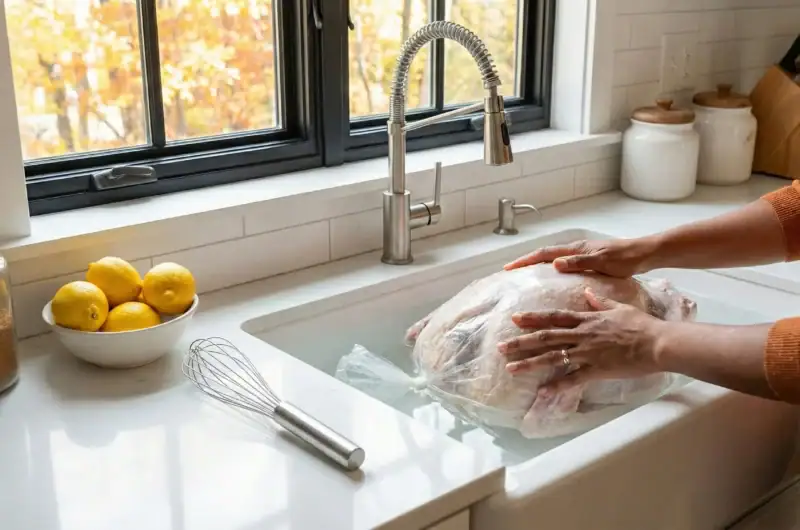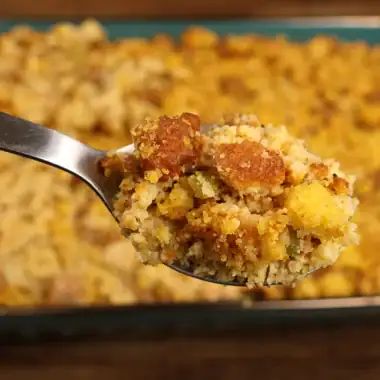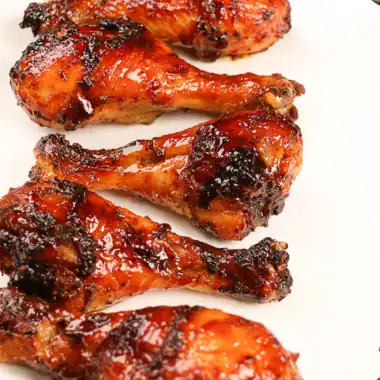Forgot to thaw the turkey? Okay, deep breath. We got this!
Forgot to Thaw Your Turkey? Here’s How to Do It Fast (Safely!)
It happens to the best of us. The sides are prepped, the stuffing is ready and dessert is cooling on the counter. Then you open the freezer… and your heart drops.
The turkey is still a rock hard block of ice.
First, take a deep breath. Do not panic. You are not the first person to face this situation and you won’t be the last. I believe every meal can be great with a little knowhow, a lot of patience and a bit of love.The good news? There are safe ways to quickly thaw a turkey, and there’s even a way to cook it while it’s still frozen. In this guide, I’ll walk you through some methods to rescue your turkey.
Why “How You Thaw” Matters
As important as a Thanksgiving meal is, preparing the turkey is one place where we can’t play around. Food safety experts warn about a temperature range called the “Danger Zone” (40°F to 140°F) where bacteria can multiply rapidly. Food should not stay in this zone for more than about 2 hours. That’s why how you thaw your turkey is just as important as how you season it. Always read and follow USDA guidelines on how to safely thaw your turkey (Food Safety and Inspection Service)
⚠️ Stop! Read This Safety Warning First
When you’re under pressure, it’s tempting to cut corners. Please don’t. The safety of your family is non-negotiable.
Here are some things you NEVER want to do:
- Never thaw a turkey on the counter.
A turkey sitting at room temperature for more than 2 hours can enter the Danger Zone, where bacteria like Salmonella can quickly grow.
- Never use hot water.
Hot water can start cooking the outside while the inside is still frozen, creating warm, unsafe pockets where bacteria thrive. - Never deep fry a frozen turkey.
This is a major fire and burn hazard. Ice in hot oil can cause a violent boil over resulting in a flash fire and potential explosion. Fire departments issue yearly warnings about this.
Stick to the three USDA approved methods:
refrigerator, cold water, or microwave — plus the safe option to cook from frozen.
Step 1: How Much Time Do You Have?
Before you pick a method, be honest about your timeline:
- Have several days? – Use the refrigerator method (safest, best texture).
- Have several hours today? – Use the cold water method (fastest safe thaw).
- Have a small turkey and a large microwave? – Use the microwave method (small birds only and only if you have no other option).
- It’s Thanksgiving day and the bird is still solid? – Use the “cook from frozen” method.
Method 1: The Cold Water Method
(The Best Fast Option)
If you have a few hours before dinner, this is the gold standard for quick thawing. It’s faster than the fridge, but still safe when done correctly.
Timing: About 30 minutes per pound.
- 10 lb turkey: ~5 hours
- 15 lb turkey: ~7.5 hours
- 20 lb turkey: ~10 hours
Step-by-Step: Cold Water Thaw
- Leave the wrapping on.
Keep the turkey in its original airtight packaging. If there’s a tear, place it in a leak proof plastic bag to prevent water from soaking the meat and to avoid contamination. - Submerge the turkey.
Place the turkey breast-side down in a clean sink, stock pot, or large cooler. Fill completely with cold tap water. - Weigh it down.
If the turkey floats, set a heavy plate, lid or pot on top so it stays completely submerged. - Change the water every 30 minutes.
This is the most important safety step. Drain and refill with fresh cold water every 30 minutes to keep the temperature low enough to stop bacteria growth but warm enough to continue thawing. - Cook immediately.
Once thawed, do not put the turkey back in the fridge for days. Cold water thawed poultry should be cooked right away.
Tip: Once thawed, pat the turkey completely dry, inside and out, before seasoning. Dry skin results in better browning and crispier skin.
Method 2: The Refrigerator “Slow & Safe” Method
(Use if You Catch It in Time)
This is the safest and most forgiving method, and it’s the one many food safety pros recommend if you plan ahead.
Timing:
Allow about 24 hours for every 4–5 pounds of turkey in the refrigerator.
- 8–12 lbs → 2–3 days
- 12–16 lbs → 3–4 days
- 16–20 lbs → 4–5 days
How to Thaw a Turkey in the Fridge
- Keep it wrapped.
Place the turkey, still in its packaging, breast-side up on a tray or rimmed sheet pan to catch juices. - Set the fridge to 37–39°F.
Cold enough to stay out of the Danger Zone, but not so cold that thawing stops. - Let it thaw undisturbed.
Don’t keep moving it around or opening the packaging. - Use within 1–2 days after it’s thawed.
Method 3: The Microwave Method
(For Small Birds Only, and as a Very Last Resort)
If you have a smaller turkey (usually 12 lbs or less) and a microwave big enough to fit it, the microwave can be used in an emergency. USDA recommends using the defrost setting and allowing about 6 minutes per pound, but review your microwave’s manual.
How to Microwave-Thaw a Turkey
- Check the manual.
Confirm the maximum turkey size, power level and minutes per pound for defrost. - Remove all wrapping and metal.
Remove any metal clips, tags or twist ties. - Use a microwave safe dish.
Place the turkey on a large microwave-safe platter to catch any juices. - Defrost using weight-based settings.
Use the defrost function (not full power). Rotate and flip the turkey several times during the thaw to reduce hot spots. - Cook immediately.
As soon as it’s thawed, the turkey must go straight into the oven. Do not refrigerate after microwave thawing.
Warning: This method can start cooking parts of the turkey (especially wings and edges) while other parts are still icy. Use only when you truly have no other option.
Method 4: The “Cook It Frozen” Method
(The Ultimate Hail Mary)
Did you wake up on Thanksgiving morning and the turkey is still a solid ice sculpture? Believe it or not, you can safely cook a turkey from frozen.
USDA and multiple food safety sources confirm that roasting a frozen turkey can be done safely. It just takes about 50% longer than a fully thawed bird.
How to Roast a Frozen Turkey
- Preheat the oven to 325°F.
Do not go lower than this. Your turkey needs enough heat to move quickly through the Danger Zone. - Place the frozen turkey on a rack in a roasting pan.
Do not season it yet. The surface is still covered in ice. - Roast for about 2 hours (for medium-size birds).
After this initial phase, the exterior will be thawed enough to handle. - Remove the giblet bag.
Once the cavity softens, carefully pull out the giblets and neck. - Season mid-cook.
Now that the surface is thawed, brush on melted butter or oil and sprinkle with your seasoning blend. - Continue roasting until done.
Use a meat thermometer — the bird is safe when:
- The innermost part of the thigh reaches 165°F
- The breast also hits 165°F
- The innermost part of the thigh reaches 165°F
Approximate Cook Times from Frozen
- 12–14 lb turkey: 4.5 to 5 hours
- 15–20 lb turkey: 6 to 7+ hours
Check early and often near the end. oven performance and temperatures vary.

Getting Flavor Into a Quick-Thawed Turkey
If you didn’t have time for an overnight brine, you will want to enhance the flavor once the turkey is thawed (or partially roasted from frozen).
1. Inject It
Use a marinade injector to place seasoned liquid deep into the meat:
- Garlic butter
- Cajun or Creole marinade
- Seasoned chicken broth
This works especially well for the breast, which tends to dry out.
2. Compound Butter Under the Skin
Gently loosen the skin over the breast and thighs with your fingers, and massage in:
- Softened butter
- Fresh or dried rosemary, thyme, sage
- Seasoned salt (like Lawry’s), garlic powder, black pepper
This puts flavor right against the meat.
3. Heavy Glaze at the End
During the last 20–30 minutes of cooking:
- Brush on honey butter, maple butter, or a brown sugar glaze
- Roast uncovered to get that deep golden, glossy skin
Just keep an eye on it so the sugars don’t burn.
Conclusion: You Saved Dinner!
A frozen turkey isn’t a disaster. It’s just a change of plans.
Whether you:
- Use the cold water method
- Microwave a small bird
- Or roast it straight from the freezer
- your family is still going to have turkey on the table.
Focus on your sides — your mac and cheese, your collard greens, your yams, etc and let the oven do the work on the bird.
Have you ever had a Thanksgiving kitchen disaster?
Share it in the comments. Your story might help another cook stay calm next year!




